Are you tired of paying a premium for department store beauty products that don’t do as much as you’d hoped they would? Have you started to worry about the health effects that may result from slathering your skin with suspicious-sounding chemicals day after day?
Perhaps you’re in search of healthier, more natural choices for beauty products. Maybe you’ve even found some good options, but you’ve been discouraged by the high price tags attached to the truly all-natural and organic products you’ve found. Or maybe you’re still searching for options that are actually natural ones – and you’d like to have more control over the ingredients that go into your products.
Would you be interested in learning how to make your own self-care products at home, using simple, step-by-step recipes and healthy, natural ingredients?
Have you ever dreamed of having your own herb garden – and the knowledge of how to use your herbs for health, beauty, well-being and healing?
Or maybe none of the above matters much to you; perhaps you’d just like to find some simple recipes and step-by-step instructions for making easy, appealing craft projects to give as gifts to your friends when their birthdays or other gift-giving occasions come up.
If any of the above situations ring true for you right now, there is a lovely, creative and inspiring recipe book you’re likely to be interested in adding to your library. It’s called Make & Give Home Apothecary by Stephanie Rose.
This book is part of a series of “Make & Give” books published by Leisure Arts. Each book in the series explores a different type of DIY project you could make for yourself, or make and give as gifts to the people on your gift list.
More Details About This Book:
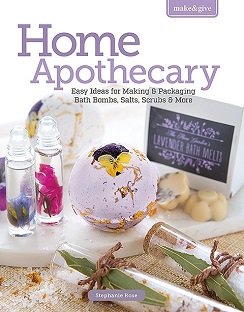
Copyright Date: 2018
ISBN 13: 978-1464774218
ISBN 10: 1464774218,
Book Formats:
This book is available in the following format(s):
Number of Pages: 64
Topics Covered in This Book:
- Making balms and bars
- Equipment you’ll need
- Double boiler and microwave methods
- Ingredients to use
- Determining product expiration dates
- How to make herb-infused oils
- Plus all the project ideas, recipes and giftwrap ideas mentioned below.
What Is an Apothecary?
An apothecary is sort of like a pharmacist, except s/he makes health and beauty enhancing concoctions using natural, herbal ingredients instead of chemical ones.
Stephanie Rose, the author of this book, epitomizes the home apothecary. She started gardening after becoming horribly ill, and she credits her garden with saving her from a life of suffering. Nowadays, she passes her knowledge of organic gardening, plants and herbs onto others through her blog and her books.
If you grow herbs and flowers like lavender, roses and violets at your place, you’ll most likely be able to use them if you decide to make any of the recipes Stephanie has shared in Make & Give Home Apothecary. But if you don’t have a garden, don’t worry – you will not be left out of the fun. Gardening isn’t the main focus of this book — and having a garden isn’t essential for using and enjoying this book.
The Focus of This Book:
This book has a couple of main focuses. The primary focus is DIY recipes for natural self-care products such as body scrubs, lip balms and bath bombs. A secondary focus is the “make and give” aspect of the book. These projects are not only intended to be things you make, but they are also intended to be gift-worthy. The book includes lovely gift presentation ideas for each project in case you want to give these items to your friends and loved ones as gifts.
Craft Projects and Recipes Included in This Book:
Botanical Bath Salts Recipe
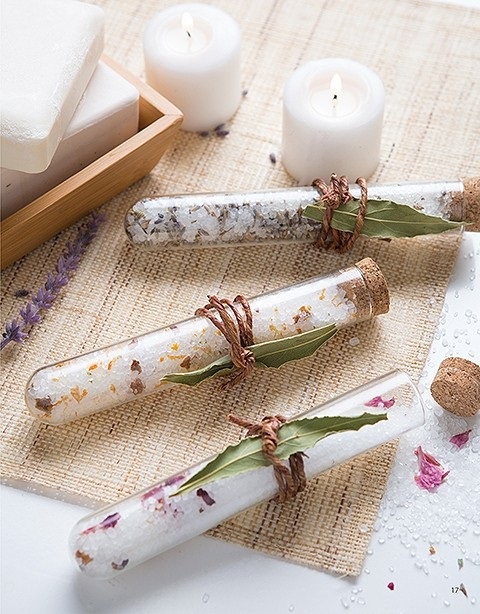
Tub Tea Recipe
Tub Tea is a lovely, refreshing alternative to bath bombs or bubble bath. This particular recipe is customizable. You can raid the contents of your pantry, herb garden or spice rack to find some — or maybe even all — of the main ingredients you need for making your Tub Tea.
Herbal Foot Soak Recipe
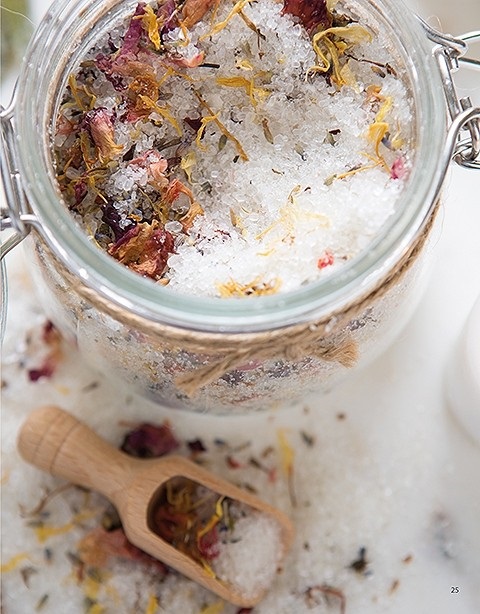
Floral Bath Bombs Recipe
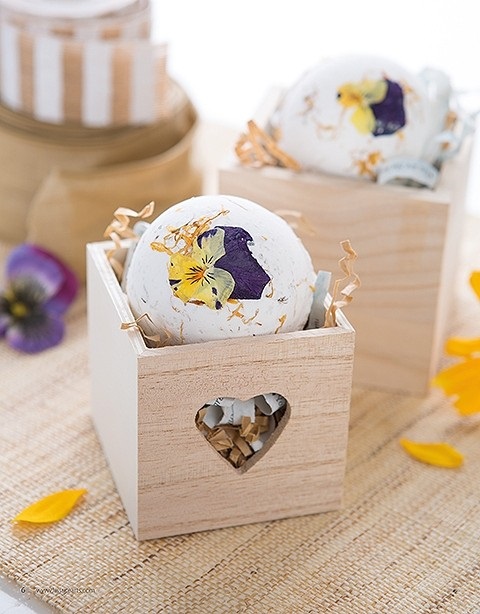
Lavender and Cocoa Butter Bath Melts Recipe
The ingredients in these bath melts are ideal for moisturizing, smoothing and hydrating your skin.
Coffee Bean Massage Bar Recipe
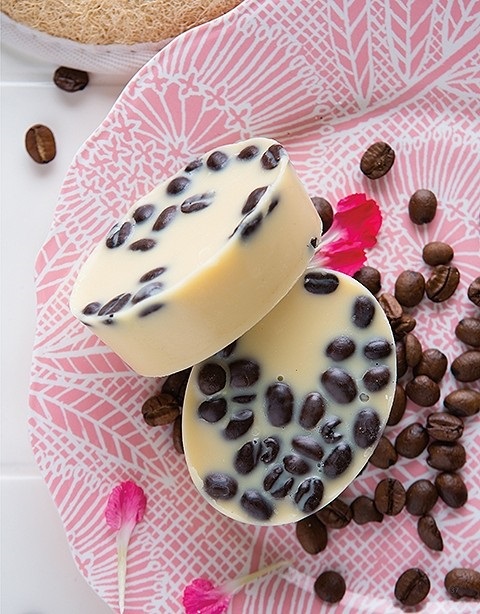
These massage bars make wonderful standalone gifts — BUT, if there’s a coffee lover on your gift list, and you really want to go out of your way to make an over-the-top, spectacularly impressive gift basket for him or her, you could pair these massage bars with some of the handmade Coffee Latte soaps from Make & Give Home Soap Making. They’d be fantastic companions.
Calendula Lotion Bar Recipe
Calendula lotion bars aren’t just a vanity item. Clinical research reveals that calendula actually has documented health benefits — particularly for people who have skin issues. Calendula can help some types of wounds to heal faster, and it is an effective remedy for diaper rash. Some people find it beneficial for fighting acne. In general, calendula is likely to promote skin hydration, elasticity and firmness.
Whether or not you (or your loved ones) suffer from any of the aforementioned issues, you can make these beautiful calendula lotion bars to enjoy the soothing effects of calendula on your own skin. I can’t wait to try making some of these for myself and my family members!
Double Chocolate Mint Lip Balm Recipe
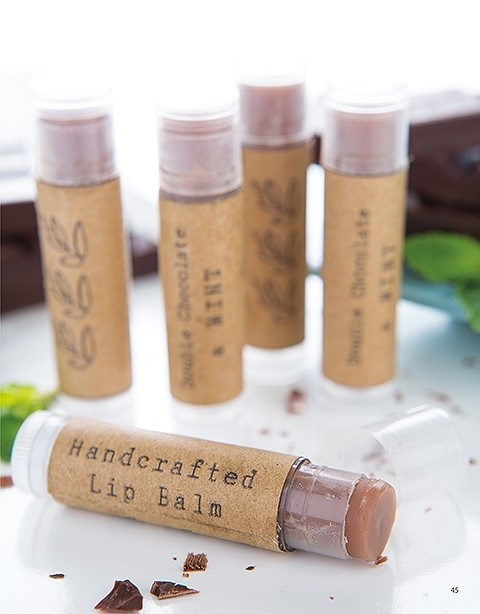
Honey Dandelion Lip Scrub Recipe
If you suffer from chapped, irritated lips, this is exactly the recipe you need for fixing the situation.
Peppermint Coconut Sugar Scrub

Healing Himalayan Pink Salt Scrub Recipe
This scrub is sooo pretty, but it is also nourishing and healing. Stephanie points out that iron is responsible for the eye-catching pink color of Himalayan salt. When you use this soak, your skin can absorb the iron and other minerals found in the salt — which can have many healing benefits for your skin.
This scrub is a wonderful standalone item to make for yourself or give to others — but if you want to make another complementary item to include in a spa gift basket, you could also whip up some of the Grapefruit Pink Himalayan Salt Soaps presented in Make & Give Home Soap Making.
Aromatherapy Perfume
There are lots of good reasons you might want to make your own perfume. Besides being a great creative outlet, there are countless health benefits to choosing your own completely natural fragrances and ingredients.
Many of the perfumes currently being sold might smell good, but they are made up of dubious synthetic ingredients that are bad for your skin — and harmful to your health overall. Some commercially available perfumes even contain toxic ingredients like phthalates that are extremely harmful. Phthalates can make you fat, interfere with the natural cycle of your body’s hormone secretions, cause miscarriages, cause birth defects and wreak untold damage on your health. Parabens are also classified as being hormone disruptors and should be avoided.
Mind you, Stephanie doesn’t go into detailed specifics about this in Make & Give Home Apothecary; but I happen to know all of this because I ghostwrite for multiple health and environmental websites, and it’s an issue I’ve researched and written about numerous times. The more I research it, the more I realize that it is downright scary.
For those of us who live in the United States, one of the scariest things is that the US government does not require fragrance ingredients to be specifically mentioned by name on product packaging — so if you buy a product that contains one of these toxic ingredients, you won’t necessarily find a mention of it on the label. These ingredients are considered “trade secrets”. The word “fragrance” in the ingredients list is a major red flag that the product contains undisclosed chemical ingredients. That “fragrance” could be icky, nasty, toxic petrochemicals, or deadly phthalates, or some other undesirable thing that really has no business going on your skin.
Right about now, some of you are probably thinking, Hold on, Amy. You mean to tell me that secret ingredients in my perfume could be making me fat? For real? I think maybe you’ve lost it.
Nope — I haven’t lost it. If you don’t believe me, here’s more info about that from a presumably reliable government website. Check it out for yourself. Notice in the advice section of the linked article, it even tells you to choose fragrance-free products. They don’t elaborate on why you should choose fragrance free products — but by now I’m betting you’re starting to get the picture about why you’d want to make your own perfume, aren’t you? This article from the Harvard School of Public Health website elaborates more on why you want to avoid “fragrances” in your personal care products.
I know it seems crazy, people. All your life, you’ve been told that diet and exercise are the only factors that will ever affect your weight. But as it turns out, a lot of what you know about weight loss is entirely wrong. There are a some things other than diet and exercise that can affect your weight. Which explains why a lot of people out there have tried to lose weight by dieting and exercise, without seeing any success. Diet and exercise are important, but they aren’t the whole story.
Here’s the truth: Your appetite is, in large part, regulated by your hormones (ghrelin and leptin, among others) — not your willpower. So if you’ve ever struggled to lose weight, you can quit beating yourself up over lack of willpower — because that’s placing the blame in entirely the wrong place. Instead, start looking around at the chemicals you’re ingesting to see if they could be adversely interfering with the regulation of your hormones.
There are multiple chemicals that can mess up your hormones. These destructive chemicals could be lurking in your perfume, your cosmetics, your shampoo, and in the plastic your food is packaged in. That’s just for starters. But if I were to go into detail about all the places you’re getting exposed to these chemicals, and all the other things you need to look out for to protect yourself, it would derail this book review entirely.
Does all of this information make you wish you had more control over what goes into your perfume? And for that matter, your other cosmetics?
Well, thanks to resources like Make & Give Home Apothecary, you have the option to take control over everything that goes into your perfume, your cosmetics and your self-care products. You can make your own perfumes and products, which will allow you to understand — and choose — and approve of every last ingredient that goes into them.
And that’s one of the reasons this book is so fantastic — and one of the reasons I am so enthusiastically putting my stamp of approval on it. These recipes contain simple, straightforward, non-toxic ingredients like mint and coconut oil and lavender. You know exactly what goes into them. There are no scary trade secrets to worry about (although I do recommend buying or growing your ingredients organically, because chemical pesticide residues in non-organic ingredients are a whole other issue to be concerned about.)
Getting back to the aromatherapy perfume recipe — This is another recipe that I am really excited to try. The ingredient list is really simple — and the project photos are soooo pretty! I imagine anyone who receives this as a gift is likely to find it delightful.
Conclusion
I recommend Make & Give Home Apothecary to anyone who is interested in making self-care products. It’s an excellent reference if you want to make and give attractive gifts to your loved ones. For some of you, it also has the potential to be a stepping stone to better health — because it is possible that these self-care products may be healthier than the ones you and your friends are currently using. If this even sounds a little bit interesting or appealing to you, I urge you to try this and see where it takes you.
Where to Buy This Book:
- Click here to shop for this book at Amazon.
- Click here to shop for this book in the author’s Etsy shop.
More Outstanding Self-Care Books and Related Resources
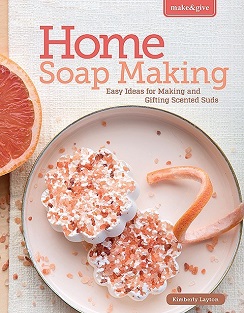
If you want to take charge of making your own personal care products, the truth is, your lip balms and body scrubs are only a small part of the picture. They’re an important part of it — but there is so much more you’ll want to consider doing. The following books and resources could help you on your journey:
- Make & Give Home Soap Making is another book in the same series from Leisure Arts. This is another book that has fantastic and beautifully presented ideas for handcrafting your own self-care products. This time, the ideas are all for soaps you can make.
These two books make wonderful companions for each other. There is no overlap between the two books, but many of the ideas presented in them complement each other. There’s no problem at all buying one without the other; they are both standalone books. But, now that I have both of these books in my personal library, I wouldn’t want to be without either of them. I’m betting you’d enjoy both these books, too.
- The Homesteader’s Herbal Companion is another book you’re likely to be interested in if you want to distance yourself from unhealthy toxic chemicals. This book is hard to describe. It’s part cook book, part self-care manual, part gardening book and part herbal encyclopedia. It will teach you to use herbs for everything from cooking to cleaning to making body care products to de-worming your dogs. It’s a pretty book, although not nearly as pretty as Make & Give Home Apothecary is; it’s also extremely practical. I highly recommend both books to anyone who wants to take better control over their own health and well-being.
- The Modern Organic Home is another book that was written by a woman on a mission to empower her own health and healing. Natalie Wise is the author of this book. She wrote it after her allergies prompted her to find a better way to houseclean than using the usual chemical-based cleaners you find at the grocery store. Her book contains numerous recipes for natural cleaners you can make at home. They’re suitable for use in every room, and on nearly every surface, in your home.
- Stephanie Rose’s website, Garden Therapy, is also a valuable resource. Stephanie’s website is primarily focused on gardening for health and healing. At one point, Stephanie became extremely ill, and that was the point when she had to begin her own healing journey. Gardening was the method she chose for outwitting the pain and suffering she was enduring. She shares more information about that at her website, along with practical tips for vegetable gardening and herb gardening organically.
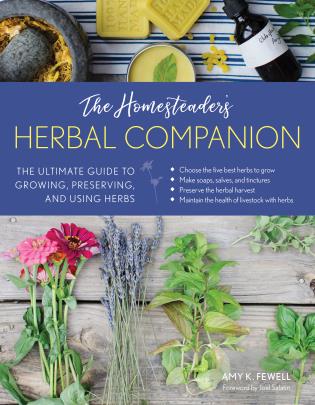
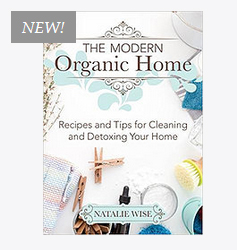
Additional References and External Links for This Article
I tried to include links to as many references as possible in the text of the article above. The following articles contain additional references and information you are likely to find helpful in making an informed decision about how you plan to proceed with choosing personal care and other products:
- At the National Institutes of Health Website: Endocrine disruptors and obesity
- At the Healthline Website: 5 Obesogens: Artificial Chemicals That Make You Fat
Posted By: Amy Solovay
About Your Book Reviewer: Amy Solovay is a freelance writer who stumbled onto natural healing when her best friend was diagnosed with a terminal illness at a time when he had no medical insurance. She offered to research natural healing methods for him, and has been interested in the topic ever since. Amy has been making crafts since childhood. She enjoys making soaps and other personal care products, and she encourages others to try making their own products, too.
This page was last updated on 8-6-2023.